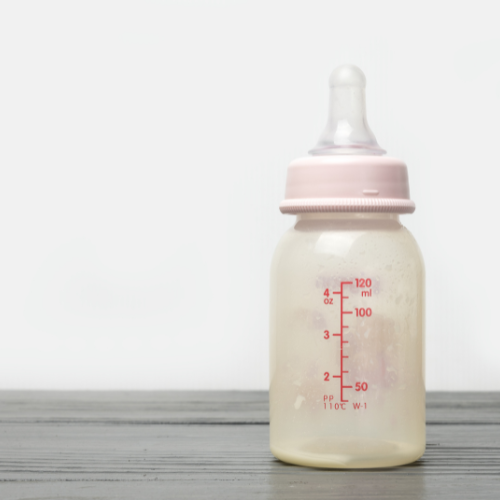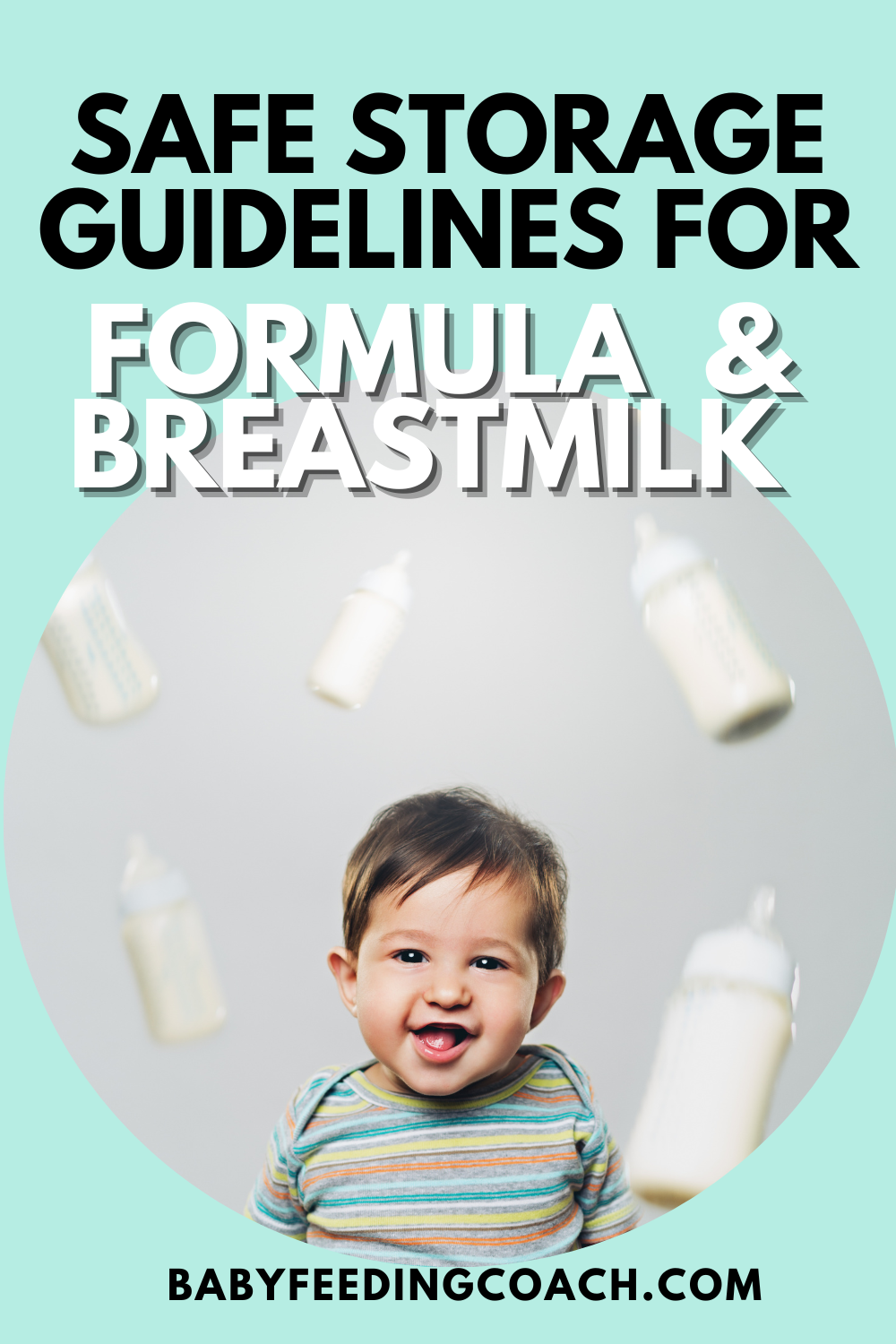Breast Milk & Combined Milk Storage Guidelines to Keep Your Baby Safe
Dec 01, 2022
There are so many questions about feeding your baby. There is a large amount of conflicting information, but keeping your baby safe is so important.
One topic I was always confused about was the safe storage of breast milk. There was so much conflicting information on social media versus what I saw from other sources.
Moreover, I was not able to find any information on safe milk storage when you are combining breast milk and formula.
in my opinion, this is a big deal. Improper storage of breast milk and formula can unfortunately lead to illness. The last thing we want to do is accidentally cause harm to our baby.
Even though I attended breastfeeding classes, I did not receive education on how to store pumped breast milk.
I remember painstakingly collecting drops of breast milk after each nursing session. I would carefully pour the few milliliters into a freezer bag.
I knew there had to be a better way when my freezer was filled with tons of bags with tiny amounts.
Cue the frantic googling of breast milk storage guidelines.
Now I know that keeping breast milk in the fridge is a-okay, but storage guidelines are important to understand because we, of course, want to keep our babies as safe as possible.
Safe storage of formula, breast milk, and combined milk can help prevent diarrhea, bacterial infections, gas, and stomach discomfort.
See! SO important.
Let’s break this down to make it easier to understand.
Breast milk storage guidelines

Did you know that how much milk is expressed, the temperature of the room, the temperature variance in the fridge or freezer, and how clean the environment is can all impact how long breastmilk can be safely stored?
Here are the CDC guidelines for storage:
-
Freshly expressed milk:
-
Room Temp: breast milk can be safely stored on the counter for up to 4 hours.
-
Fridge: Up to 4 days.
-
Frozen: It is best used within 6 months but should not be used after 12 months.
-
Pro tip: store breast milk in the back of the fridge or freezer where the temperature doesn’t fluctuate as much.
-
-
Thawed or previously frozen breast milk:
-
Room temperature: it should be used within 1-2 hours after the last milk crystal has melted.
-
Fridge: Up to 24 hours after the last milk crystal has melted.
-
Frozen: Never re-freeze milk after it has been thawed.
-
-
Leftover milk from a feeding: No matter what, use it within 2 hours after the feeding starts.
For reference, when I state room temp, fridge, or freezer, these are the recommended temperatures:
-
room temperature: 77 degrees or cooler
-
refrigerator: 40 degrees or cooler.
-
freezer: 0 degrees or colder.
Yes, that means that if your house is warmer than 77 degrees Fahrenheit, your milk may spoil faster.
Breast milk storage guidelines & tips:
-
Make sure to label the milk with the date it was expressed and store it in 2-4 oz increments to minimize waste (this also depends on how much your baby eats per feed)
-
Remember, you can combine milk from different pumping sessions as long as it is the same temperature and not expired.
-
You can also store milk immediately after pumping.
-
-
Breast milk expands when it is frozen, so make sure to not overfill your bags or storage containers.
-
If you have a childcare provider who will be feeding the milk to your child, make sure to label the milk with the child’s name to avoid any confusion.
What are the best breast milk storage freezer bags?
-
First, the business...Always use milk storage bags or food-grade containers.
-
Avoid using disposable bottle liners or plastic baggies. They are not meant to store milk for extended periods of time and can leak or easily be contaminated.
-
These are storage containers that I use a ton and love.
-
Lansinoh storage bags: These bags are simple, effective, and are made with BPA-free plastic. I have never had one leak on me after using them with two babies. They are a good space-saving option.
-
Matyz glass storage containers: I absolutely love these and use them multiple times per week for various reasons. They are sturdy and hard to break. I've had the same 6 containers and used them for both of my babies.
-
Nuliie silicone breast milk storage bags: These are new to me, but are a nice alternative to plastic. They have not leaked while using them and can be used for other reasons aside from breast milk storage.
-
How to safely thaw breast milk
Thawing breast milk from the freezer should be done with care to ensure the safety and quality of the milk. First, defrost the oldest milk first since nutrients may decrease over time.
Refrigerator thawing
-
The best and safest method for thawing frozen breast milk is in the refrigerator.
-
Place the frozen breast milk container in the refrigerator and allow it to thaw slowly.
-
Thawing breast milk in the refrigerator may take around 24ish hours.
Pro tip: You can re-freeze breast milk that is defrosting as long as there are still milk crystals in the container.
Warm water thawing
-
Under lukewarm running water
-
Use breast milk within 2 hours of bringing it to room temperature or after it is warmed. It is best practice to not warm breast milk a second time after it has been heated up.
Is it okay to thaw breast milk in the microwave?
The microwave seems like it would be a good option, but it isn’t recommended. Using high heat can create hot spots and potentially burn your baby. It may also break down important nutrients found in breast milk. Other methods are safer for your baby.

When preparing baby formula, the most important rule is to read and reread the instructions on the label! I can't tell you how many times parents believe they are mixing it correctly only to find out that is not the case.
The CDC also has guidelines for proper baby formula storage:
-
Room Temp: Prepared formula should be used within 2 hours after it has been prepped.
-
Fridge: Up to 24 hours if your baby has not drunk from the bottle.
-
Freezer: NEVER freeze formula. Freezing can change the properties of the formula and make it unsafe for your baby.
-
Throw out any formula in the bottle your baby did not consume within one hour. The mixture of formula and the baby’s saliva can cause bacteria to grow.
-
Store unopened cans of formula in a cool, dry environment. Avoid places with large fluctuations in temperature and humidity (like most garages).
-
Opened cans of formula should be stored with the lid tightly secured and in a cool, dry environment (not the fridge). Opened cans of formula should be used within 1 month.
-
Pro tip: write the date on the lid when you open it so you know when it was opened and how long you have to use it.
-
If you are using ready-to-feed formula, follow the instructions on the bottle. They are usually good for about 24-48 hours in the fridge.
With any formula, follow the guidelines and never use it after the “Use by” date and throw out or return any cans with dents in them - it can compromise the seal, and bacteria can grow.

Combined Milk Storage Guidelines
Some parents may combine both breast milk and formula in the bottle.
Unfortunately, there are no official guidelines on how to properly store combined milk.
I recommend following formula guidelines, as bacteria grow quicker in formula than in breast milk.
You can also prepare the formula separately, and combine it with breast milk before heating or serving.
Feeding your baby is one of the most basic yet complicated things you will do for your child. By following the storage guidelines outlined above, you can ensure your baby will be well-fed with a happy tummy.
>>> Motherhood is hard, but feeding your baby doesn't have to be! Schedule a one-on-one consult so you can worry less and enjoy your baby more. <<<
*This post may contain affiliate links. If you purchase using my links, I get a small portion of the money which helps me offer you free content.

>>> Tired of worrying about feeding your baby? Get personalized support so you can enjoy feeding your baby. <<<
Free Resource for Parents and Medical Providers:
The Baby Feeding Database
Helping you understand what formulas are available and narrow down what is best for your family.
This will sign you up for the Baby Feeding Coach email list. I will not spam you. Opt out anytime.


